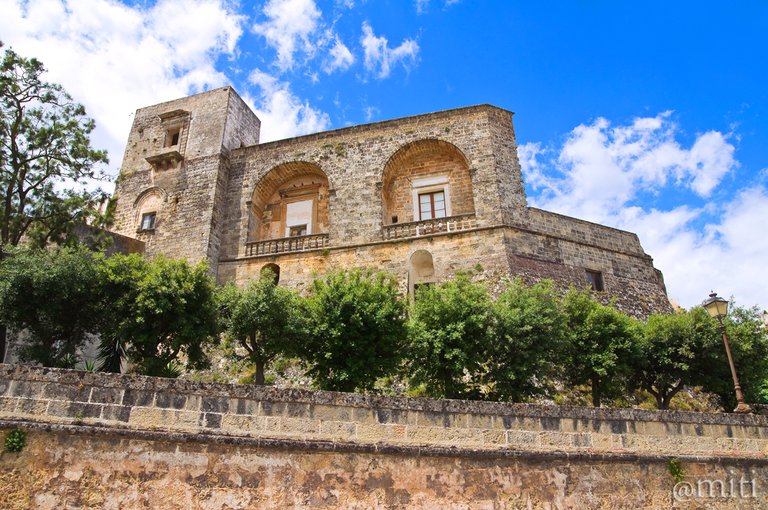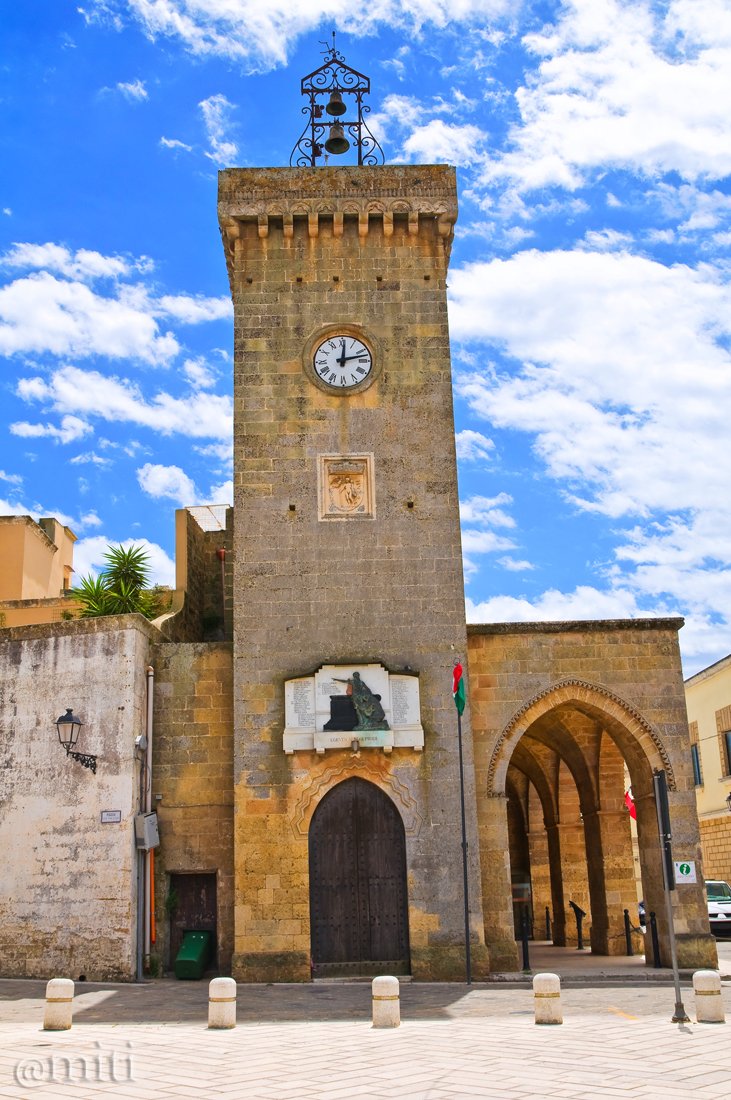
The Castle D'Amore (Author's photo - All rights reserved)
Il Castello D'Amore (Immagine dell'autore - tutti i diritti sono riservati)



Ciao a tutti,
questo è un viaggio attraverso l'Italia. Posterò una foto al giorno con una brevissima descrizione. Spero vi piaccia!

Ugento è un piccolo borgo della provincia di Lecce, nella regione italiana meridionale della Puglia. Si trova sul basso altopiano chiamato Murge, su un territorio per lo più pianeggiante interrotto da cumuli di pietre, con scogliere che si protendono sul mare.
È un paese molto antico, come si può vedere dai numerosi siti archeologici della zona. La sua storia antica risale alle tribù dei Massapi ma furono i Romani a dargli il nome di Uxentum.
Le origini di Ugento non possono essere provate dai documenti ma grazie al recupero di menhir, dolmen e mura messapiche siamo sicuri che questo villaggio fu fondato durante l'era preistorica.
Ci sono due menhir: uno è situato a Gemini (una frazione di Ugento), l'altro è nella fattoria di Terenzano. I dolmen (monumenti funerari) sono stati distrutti da alcuni agricoltori che non ne hanno percepito l'importanza.
Per quanto riguarda invece le mura messapiche, esse costituiscono la prova dell’insediamento del popolo messapico.
Ugento è situato nell'entroterra dal Mar Ionio, nel mezzo di una ricca zona archeologica. Qui è stata ritrovata una statua in bronzo di Zeus del V secolo aC, testimonianza della presenza greca di molti millenni fa. E' possibile vedere importanti reperti nel Museo Colosso, una collezione privata ospitata nello splendido Palazzo Colosso.
Ugento fu saccheggiata dai turchi, poi fu ricostruita e divenne sede episcopale nell'undicesimo secolo.
La caduta dell'Impero Romano iniziò un declino e l'area fu ripetutamente saccheggiata da Goti, Longobardi e Saraceni.
Il castello angolare trapezoidale fu costruito nel 13 ° secolo. È stato ridisegnato per diventare un maniero regale nel periodo rinascimentale.
Il centro storico ha una varietà di stili: dal Castello D 'Amore, alla Cattedrale in stile gotico del XVII secolo dedicata a Santa Maria Assunta (sede di una delle più antiche chiese del sud Italia), fino al Chiesa di Sant'Antonio e il palazzo vescovile. È un percorso affascinante quello che porta alla scoperta delle chiese rupestri, come la Cripta del Crocifisso e la Chiesa della Madonna di Costantinopoli, la Chiesa di Santa Maria del Casale.
Tra le torri costiere costruite per proteggere la costa dagli attacchi turchi, Torre San Giovanni è la più antica. Oggi è usata come faro e la meravigliosa costa si estende sotto di essa, con spiagge di sabbia e fondali con acqua cristallina.
Cose da vedere: il centro storico, il Castello D 'Amore, il Duomo, la Chiesa di Sant'Antonio, il Palazzo Vescovile, la Cripta del Crocifisso, la Chiesa della Madonna di Costantinopoli, la Chiesa di Santa Maria del Casale, la Torre San Giovanni, il Museo Adolfo Colosso, la Statua di Zeus, il Museo Archeologico, la Torre dell'Orologio, Palazzo Colosso.

Hello everyone,
I began a Photo Journey through Italy. I will post one photo every day with a little note of explanation. I hope you like it!

Ugento is a small town in the province of Lecce, in the southern Italian region of Puglia. It is Situated on the low plateau called Murge, on a mostly level territory interrupted by stony heaps, with cliffs protruding over the sea.
It is a very ancient town, as can be seen from the many archaeological sites in the area. It's ancient history reaches back to the Massapic tribes but it was the Romans who gave it the name Uxentum.
The origins of Ugento cannot be proved by documents but thanks to the recovery of menhirs, dolmens and Messapian Walls we are sure that this village was founded during the prehistoric age.
There are two menhirs: one is situated at Gemini (a frazione of Ugento), the other one is at the Terenzano Farm. The dolmen (funeral monuments) were destroyed by some farmers who could not perceive their importance.
As far as the Messapian Walls are concerned they represent a real proof of the Messapian people' settlement.
Ugento is just inland from the Ionian Sea, in the midst of a rich archeological zone. A bronze statue of Zeus from the 5th century BC was found here, testimony of the Greek presence many millennia ago. You can see important artifacts in the Colosso Museum, a private collection housed in the splendid Colosso Palace.
Ugento was sacked by the Turks rebuilt and became an episcopal seat in the 11th century.
The fall of the Roman Empire started a decline, and the area was repeatedly sacked by Goths, Lombards and Saracens.
The angular trapezoidal castle was constructed in the 13th century. It was restyled to become a regal manor house in the Renaissance period.
The historic centre has a variety of styles: from the Castle D’ Amore, to the 17th – century gothic-style Cathedral dedicated to Santa Maria Assunta (hosting one of the most ancient practicing churches in the south of Italy), as far as the Church of Sant’Antonio and the bishop’s palace. It is a fascinating route the one which takes to discover the rocky churches, such as the Crypt of the Crucifix and the Church of Madonna di Costantinopoli, the Church of Santa Maria del Casale.
Amon the coastal towers built to protect the coast from Turkish attacks , Torre San Giovanni is the oldest one. Today, it is used as lighthouse and the wonderful coast stretches under it, with sand beaches and sea beds with crystal-clear water.
Thing to see: the Historical centre, the Castle D’ Amore, the Cathedral, the Church of Sant’Antonio, the Bishop’s Palace, the Crypt of the Crucifix, the Church of Madonna di Costantinopoli, the Church of Santa Maria del Casale, the Torre San Giovanni, the Adolfo Colosso Museum, the Statue of Zeus, the Archaeological Museum, the Clock Tower, Colosso Palace.

| Tipo di foto / Category | Paesaggio / Landscape view |
| Esposizione / Settings | 1/250 sec, ISO 200, f/10 |
| Camera | Nikon D5000 |
| Lente / Lens | Tamron SP 17-50mm f/2.8 XR Di II LD |
| Filtro / Filter | Polarizzatore Hoya / Hoya Polarizing filter |
| Cavalletto / Tripod | Manfrotto MKC3-P01 |
| Località / Location | Ugento (Lecce), Italia |
| Software | Photoshop |


The Clock Tower (Author's photo - All rights reserved)
La Torre Dell'orologio (Immagine dell'autore - tutti i diritti sono riservati)
Your scene impressed me.Beautiful photo. So very nice.Thanks a lot.
Congratulations, Your Post Has Been Added To The Steemit Worldmap!
Author link: http://steemitworldmap.com?author=mitiPost link: http://steemitworldmap.com?post=a-journey-through-italy-one-photo-every-day-143-ugento-eng-ita
Want to have your post on the map too?
A dir poco è SPETTACOLARE: grazie @miti!
Figurati caro, esporto le bellezze d'Italia nel mondo :D
Wow!!
Wonderful photography>
Love it dear miti. All the best...
Thanks!
Wows...!! 😱
Very beautiful place and lovely photoshoot..my dear friend miti...really i love your photography..
I'm glad you like them!
its a nice photo series you are maintaining. Needless to say that photo is superb.
Oh, thank you!
Great pictures. I’d like to see closeup pictures of the details on the clock tower.
You got a 69.65% upvote from @ocdb courtesy of @miti!